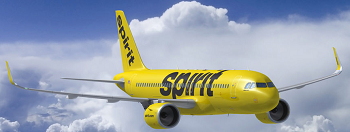Starting Out…
Spirit Airlines To Present At The International Aviation Forecast Summit
Over 100 additional airliners coming on line. New service innovations at airports. New markets & routes.
Bank on it: Spirit Airlines is going to be a major factor in the changes coming to the U.S. airline system.
 That’s why we are honored to announce that Mr. Ted Christie, CEO of Spirit, will be at the IAFS, delivering his views and perspectives of the exciting new future of the ULCC segment, and how it will affect airlines, airports and communities. The 25th annual IAFS will be on August 23-25, in Cincinnati, USA.
That’s why we are honored to announce that Mr. Ted Christie, CEO of Spirit, will be at the IAFS, delivering his views and perspectives of the exciting new future of the ULCC segment, and how it will affect airlines, airports and communities. The 25th annual IAFS will be on August 23-25, in Cincinnati, USA.
No Panels… Instead, Exploration of the Future. As usual with the IAFS, the format will be open and free discussion of the areas that Mr. Christie and Spirit see as shaping how airports, suppliers and communities need to plan and vision the future. At this event, we explore the future, instead of straight-jacketing presenters into predetermined subject panels.
Spirit is just one of the U.S. and global airlines that will be participating in exploring the future.
Executives from American, Delta, United, Southwest, and more are on the agenda this year, too.
Plus, forecasts of traffic from our Airports:USA data system, covering trends and emerging disruptive dynamics that will deliver the future, instead of rehashing the past. Experts from all areas of the industry will be there, outlining areas such as new propulsion systems… drones and the future of air logistics… challenges for airports in planning for systems and dynamics that weren’t even thought about five years ago.
Special Early Registration Rates. Register now, and take advantage of low New Year registration rates through January 30. If you can attend only one event in 2020, this is the one that delivers information, forecasts and perspectives no other event comes close to.
Click here now, and get a jump on the future!
_____________
Sorting Out The Max Situation
A lot of speculation regarding what the Max mess will mean to the US air transportation system.
As a matter of reality, it appears that AA, UA, WN and AS won’t have the 737 Max fully back into their schedules until the end of 2020 – at best.
Currently, American and Southwest have assumed a June re-entry, but even that is still tentative. And even then, it won’t be immediate, either.
What needs to be kept in mind is that it’s not a simple matter bringing, say 40 – 45 stray airliners back into an airline system.
One major issue is pilot training… if the requirement is determined to be instruction in 737 Max-specific simulators, there’s going to be one whale of a backlog, as there are less than 30 such devices in existence today across the globe.
Waking A Fleet of 800 Airplanes. As of today, there are just short of 800 Max airliners on the ground, split near evenly between those grounded last March and those that have come off the production line since then and un-delivered.
Getting those flying machines un-pickled, lined up into modification centers, and back in airline schedules is going to take a lot of time, both for Boeing and for the carriers involved.
Therefore, don’t put much credibility in stories that a Max approval will result in a sudden capacity glut, causing fares to plummet. More veneer reporting. The process will be anything but sudden.
Not only will these airliners come back gradually, but every single one – bank on it – has a schedule line ready and waiting. In the US, Southwest hasn’t been able to add a single airplane since March, in the face of huge market opportunities.
Ditto for United and American – even though they have been continuing to add narrow-body A319s and E-175s to their system fleets over the last nine months. (American last week took delivery of another used A319 from China Southern, for example.)
In any event, continue to plan on a 3.0% – 3.5% growth in US airport enplanements in 2020 – and a June Max approval will not have much effect.
__________
And Finally…
Maybe There’s A Reason Facebook Is Banned In China
In the next two years, BGI forecasts predict that several more US interior, non-hubsite airports will be targets for EU carriers and alliances looking for feed traffic.
Airports and communities that plan now, based on clear, defined outreach strategies, will be first in line. This week, an event across the world may be a lesson on one of the major pitfalls that can post a de facto “keep out” sign for foreign interest.
Communicate. Don’t Translate. In China-related projects, we advise our airport and business clients to never, ever use machine translation programs for anything – websites, brochures, news stories, whatever.
Those things just translate words, not context, and invariably result in at best clumsy, laughable results. And sometimes, quite embarrassing ones.
Facebook, just found this out…
According to several sources, Facebook used its machine translation programs to report on a state visit to Myanmar by the president of China, Mr. Xi Jinping.
On the world stage, he’s sort of a powerful guy.
Unfortunately, Facebook’s system is apparently so clumsy that it blindly even attempts to translate peoples’ names into English, which is not only impossible, but completely at odds with professional work.
See, “Roberto” is never translated into “Robert.” “Miguel” is never “Michael.”
And, as Facebook just discovered in their translation of the Burma-China meetings…
… “Xi Jinping” really doesn’t translate into “Mr. S**t Hole,” which – incredibly – was what Facebook’s system generated and which was used throughout the article, and reportedly not corrected for many hours or even a few days. Perhaps because the pronunciation of “Xi” is phonetically “shee” – it may have sent Facebook’s system in a very wrong direction.
Smooth.
China is just a leeetle intolerant of any criticism of its leader-for-life. They have actually banned Winnie-The-Pooh because the cute bear has been compared to President Xi. So this oughta really see the well known substance hit the electrical convenience, at least as far as Facebook is concerned
Airports: Do Take A Hint. There is a message here for any airport or community looking to build international traffic.
It takes professional outreach and communication. Expressing thoughts and ideas in another language demands an understanding of all the aspects of that language – idioms, syntax, sentence structures, etc. As an example close to home, you’d be surprised at the number of businesses looking to expand in Quebec that have gotten burned by having things translated into the French spoken in France.
So if you have an international plan – and indeed, most mid-size and larger US airports should have one – make sure you’re focused and professional.
If your website includes one of those machine-generated “choose the language” options, cut it off. Like, right now. It probably isn’t as offensive as what Facebook just stumbled into, but you can bet that it isn’t raising your image on the world stage.
Sure, listing 15 languages for your website sounds real “global” – but doing it this way just makes you look, well, like Dogpatch. Uninformed and not real aware.
Plus, even if it were translated properly, U.S. airports attempting to get points with the Urdu-speaking community in some far-off country probably won’t do much for recapturing leakage.
It Can Be Done Right – If You Have A Clear Need That Justifies The Investment. But if you are intending to reach out to China, which will be the #1 global aviation market in a couple years, and one that has over $140 billion invested here, give us a call.
We can explore the possibilities. It might make some sense, depending on the levels of business interaction. But it should be done as part of a clear outreach plan, based on market and commercial possibilities, and not as a shiny object to impress the folks in town.
Unlike dimbulb translation machines, we know both aviation and China, and we can deliver websites, promotional brochures and China-registered business WeChat apps that will showcase the specifics of your community and your airport in China. They are not “translated” but instead created in professional business Chinese.
Yes, it will cost more than a free Google app.
But it will communicate a lot better than comparing the president of China to an outdoor convenience.
________
ALL OF US AT BOYD GROUP INTERNATIONAL WISH YOU A GREAT AND PROSPEROUS WEEK!


